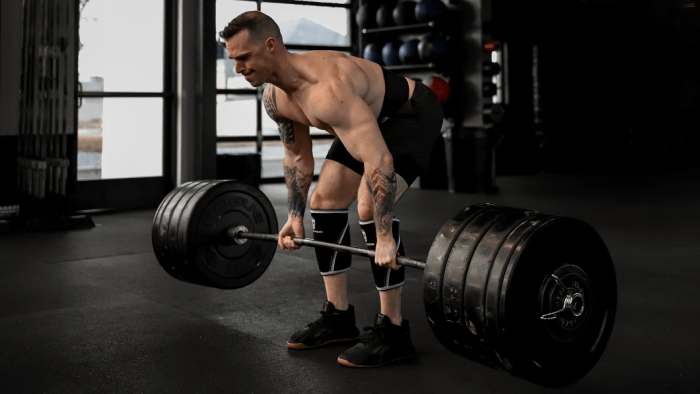At What Weight Should I Use a Belt for Deadlifts? Like a sailor using a compass to navigate treacherous waters, you, too, must learn to use your tools wisely when lifting. The question of when to introduce a belt into your deadlift routine is multifaceted.
It’s not just about the weight you’re lifting but also your form, core strength, and training goals. Most importantly, it’s about safety.
So, let’s explore the factors you must consider to determine the right weight for belt use in your deadlifts.
Contents
The Belt’s Role in Deadlifting:
Often, you’ll find that a lifting belt provides additional support and stability to your torso during heavy lifts, such as the deadlift. The belt benefits are manifold; it acts as a brace for your lower back, thus reducing the risk of injury.
The belt creates intra-abdominal pressure, helping you maintain a better form and posture during the lift and enhancing performance. It’s not a magical tool but a device to prevent injury. It’s crucial to understand that the belt doesn’t replace the need for a proper lifting technique.
Form Evaluation: Deadlifts Under the Microscope
Before even considering strapping on a belt for deadlifts, you must have your lifting form down pat. A poor form can lead to injuries and limit your lifting potential. You should focus on two fundamental aspects: your grip technique and foot placement.
- Grip Technique: Your grip plays a vital role in lifting the weight off the floor and maintaining control throughout the lift.
- Overhand Grip: It’s the standard grip for deadlifting, where your palms face your body.
- Mixed Grip: One hand faces away from you, the other towards you. It’s usually used for heavier lifts.
- Foot Placement: Positioning your feet correctly can enhance stability and power.
- Conventional Stance: Feet hip-width apart.
- Sumo Stance: Feet wider than hip-width, toes pointing slightly outward.
Perfect these elements before adding a belt to your routine.
Core Power: A Pillar in Deadlift Success
You’ll find that a strong core is one of the most crucial factors in executing a successful deadlift. Core conditioning enhances your overall stability, helps promote better posture, and reduces injury risk.
With proper abdominal engagement, the force you generate won’t just be from your arms or legs but your entire body. When lifting heavy, this core-generated force keeps you grounded and allows for a smoother, more efficient lift.

Your core essentially acts as a bridge between your upper and lower body, transferring the power your legs generate to your arms. So, before you consider strapping on a belt, focus on strengthening your core.
This won’t only improve your deadlift but your overall lifting performance, too.
Weighty Matters: Choosing the Right Load
Consider your training goals carefully when deciding whether or not to incorporate a belt into your deadlift routine. Your goal assessment should consider your current physical condition, training progression, and overall fitness objectives.
Here’s a simple guide:
- If you’re a beginner, you mightn’t need a belt yet. Focus on:
- Building your core strength
- Perfecting your form
- For intermediate or advanced lifters, a belt could be beneficial. Contemplate:
- Your current max lift
- Your comfort level lifting heavy weights
Buckle Up: Deciding When to Use the Belt
There’s no one-size-fits-all answer to choosing the right weight for utilizing a belt in your deadlift routine. Belt sizing considerations and injury prevention strategies should guide your decision.
Listen to your body. If you’re straining excessively or experiencing pain, a belt may help. Remember, a belt isn’t a quick fix to lift more weight. It’s a tool to enhance form and safety.
Belt sizing is critical. An ill-fitting belt won’t provide the correct support, possibly leading to injury. Measure your waist at the belly button for an accurate size.
Your injury prevention strategy should include proper form and strength building. Using a belt too early can hinder the development of your core and lower back muscles. Introducing a belt when lifting a weight significantly challenging your strength is best.
Frequently Asked Questions:
When choosing a belt for deadlifting, consider the material and brand. Leather belts provide durability and support. Brands like Inzer and Rogue are renowned for quality. It’s about your comfort, not just the weight you’re lifting.
You should frequently incorporate beltless training into your routine to improve your deadlift techniques. Please don’t rely on a belt too often; it’s beneficial to naturally strengthen your core and lower back muscles.
Yes, it can. Over-reliance on a belt can lead to belt dependency risks like weakened core muscles. However, proper safety precautions make you less likely to cause injury while deadlifting with a belt.
No, you don’t need to adjust your diet when using a belt for deadlifts. Belt sizing importance lies in comfort and support, not your weight. However, maintaining macronutrient balance adjustments optimizes overall fitness performance.
Sure, you can improve your deadlifts without a belt. Focusing on proper lifting techniques and avoiding common deadlift form mistakes can significantly boost your performance. It’s about mastering the basics, not the tools.
Conclusion:
In conclusion, remember, a belt’s not a quick fix for poor form or lack of core strength. It aids heavier lifts, typically above 80% of your max deadlift.
Research shows, surprisingly, that belt usage can increase power and velocity during deadlifts. So, weigh your training goals, work on your form and strength, and decide if you need that extra support.
It’s about making smart, safe choices for your body.

Santhan, known to many as Linda, combines her personal training expertise with exceptional motivational coaching skills. Her articles are not just informative but also incredibly inspiring, encouraging readers to take action and pursue their fitness goals. Linda’s unique approach to writing integrates practical fitness guidance with motivational elements, making her content both useful and uplifting.
